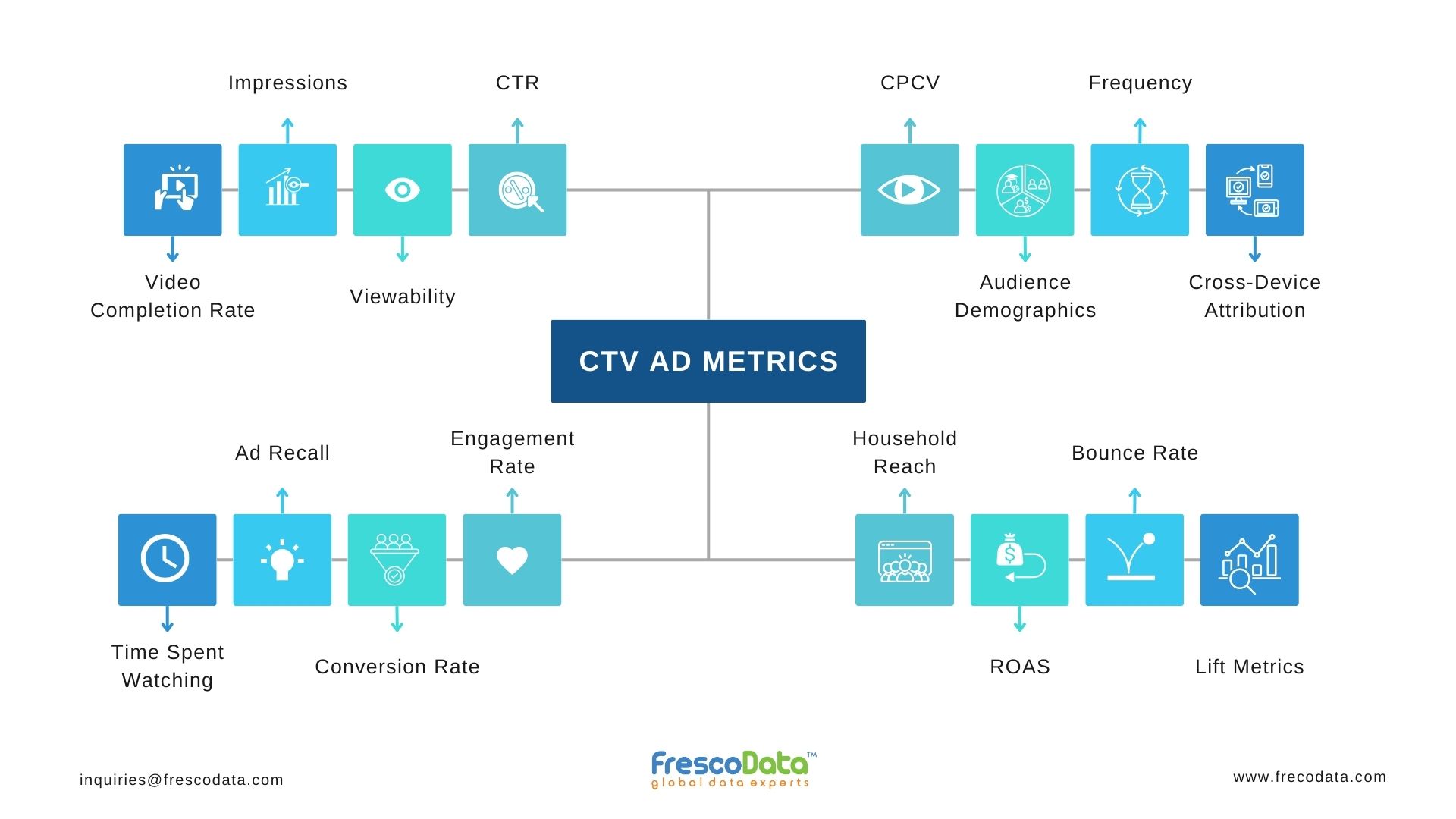Unlike traditional TV advertising, CTV advertising allows advertisers to thoroughly track the reach of their ads & monitor the user journey across different devices.
It provides detailed insights into CTV ad campaigns & thus advertisers have the leverage to analyze different metrics, which wasn’t possible with traditional TV ads.
However, to make the most out of CTV ad campaigns, it’s crucial to focus on the right CTV metrics, as there are different CTV metrics for different CTV Ad Formats.
It will not only help in refining your targeting strategies but also ensure that your campaigns deliver the desired outcomes.
Here are 16 essential CTV metrics to consider:

1. Impressions
Impressions refer to the total number of times your ad is displayed on a CTV device. While it doesn’t account for whether the ad was viewed entirely, it’s a fundamental metric for understanding your ad’s reach. Monitoring impressions helps in gauging the potential exposure and adjusting the frequency to avoid ad fatigue.
2. Video Completion Rate
Video Completion rate is the percentage of viewers who watch your ad to the end. A high completion rate indicates that your content is engaging and relevant to your target audience. It also suggests that the placement and length of your ad are optimized, which is crucial for maintaining viewer attention and improving brand recall.
3. Viewability
Viewability measures whether your ad was actually visible to the audience when it played. This metric ensures that your ad isn’t just playing in the background or being skipped. High viewability rates are essential for validating the effectiveness of your placements and maximizing your return on investment.
4. Click-Through Rate (CTR)
CTR is the ratio of viewers who clicked on your ad to the total number of impressions. Although CTV ads are typically less focused on direct clicks compared to other digital ads, CTR still provides insights into the interactive potential of your content. A higher CTR indicates that your ad is compelling enough to prompt viewers to take immediate action.
5. Cost Per Completed View (CPCV)
CPCV is a cost-efficiency metric that measures how much you’re paying for each completed view of your ad. It’s a critical metric for assessing the financial effectiveness of your campaign. Lowering your CPCV without compromising on the quality or relevance of your ad can significantly improve your campaign’s ROI.
6. Audience Demographics
Understanding who is viewing your ads is essential for refining your targeting strategy. Metrics related to audience demographics, such as age, gender, location, and interests, allow you to tailor your ads more effectively. By analyzing this data, you can ensure that your content resonates with the right segments and adjust your targeting accordingly.
7. Frequency
Frequency refers to how often your ad is shown to the same viewer. While repeated exposure can increase brand recognition, overexposure can lead to ad fatigue and negative perceptions. Monitoring frequency helps in finding the right balance between ensuring sufficient exposure and avoiding over-saturation.
8. Cross-Device Attribution
Cross-device attribution measures how your CTV ads contribute to conversions across multiple devices.
It helps in determining how your CTV ad influences the viewer’s path to conversion. Whether it’s driving traffic to a website, generating leads, or making a purchase, it allows you to credit your CTV ads accurately for their role in the customer journey.
Since viewers might see your ad on TV but convert on a mobile or desktop device, this metric provides a more comprehensive view of your campaign’s effectiveness.
9. Engagement Rate
Engagement rate goes beyond just clicks, encompassing all forms of interaction with your ad, such as pauses, rewinds, and other interactive elements. A higher engagement rate suggests that your content is resonating well with viewers, making it an important metric for understanding the depth of audience interest.
10. Ad Recall
Ad recall measures how well viewers remember your ad after seeing it. High ad recall indicates that your ad made a strong impression, which can be critical for brand awareness campaigns. Surveys or post-view exposure analysis can help you gauge this metric.
11. Conversion Rate
Conversion rate tracks the percentage of viewers who take a desired action after seeing your ad, such as making a purchase, signing up for a newsletter, or downloading an app. This metric is crucial for measuring the direct impact of your ad on your business objectives.
12. Time Spent Watching
This metric measures how long viewers spend watching your ad. If your ad is skippable, this metric can provide insights into how engaging your content is. The longer the time spent, the more compelling your ad is likely to be.
13. Household Reach
Household reach refers to the number of unique households exposed to your ad. This metric helps you understand the breadth of your campaign’s reach, particularly in a CTV context where multiple viewers might be watching from the same household.
14. Return on Ad Spend (ROAS)
ROAS calculates the revenue generated from your CTV ads relative to the amount spent on them. It’s a vital metric for evaluating the overall profitability of your campaign. A high ROAS indicates that your ads are generating significant returns on your investment.
15. Bounce Rate
While more commonly associated with website metrics, bounce rate can also apply to CTV ads that direct viewers to a landing page or app. A high bounce rate may indicate that the landing experience doesn’t align with the expectations set by the ad, necessitating adjustments to improve conversion.
16. Lift Metrics
Lift Metrics measure the increase in brand awareness, consideration, or purchase intent as a direct result of your CTV ad campaign. These metrics often require control groups for comparison and are particularly useful for understanding the broader impact of your advertising efforts.
These are some basic CTV metrics that you should consider while running CTV ads. These CTV metrics, when combined, give a comprehensive overview of your CTV ads.




